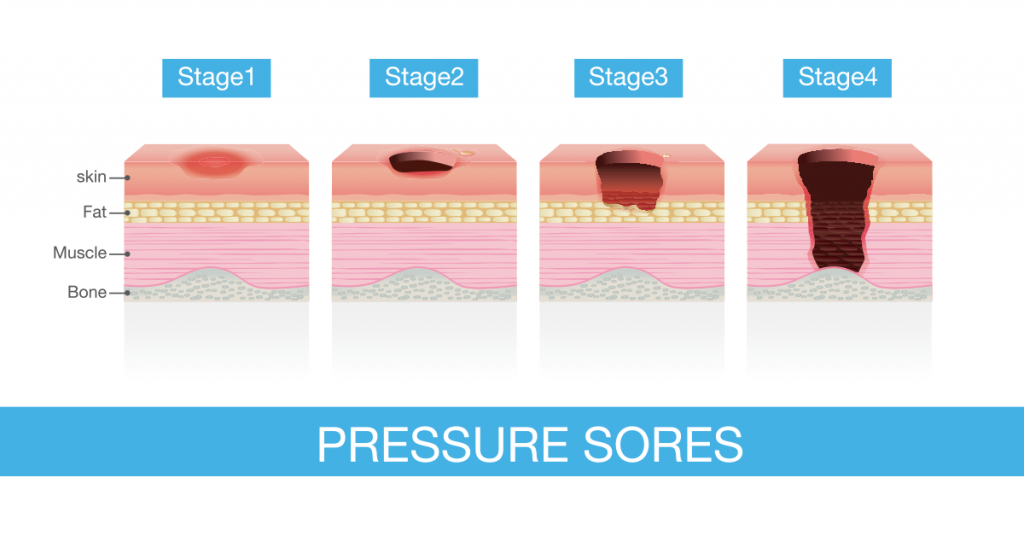Pressure ulcers are a persistent plague when it comes to patient recovery. Better known as bedsores, bedridden patients are most prone to them due to too much pressure on the skin. They most commonly occur on areas with minimum muscle and fat such as the shoulder blades, tailbone, elbows, heels and hips. While they initially cause pain and discomfort, they can lead to infections or worse, if not treated properly or in time.
As care managers, we are accustomed to seeing the effects of pressure ulcers and how they may inhibit rehab progress. We are always able to provide our clients and their loved ones with the basics when it comes to preventing bedsores and can steer them in the right direction for treatment and care.
To keep it simple, we have divided the necessary preventive care into three parts:
Repositioning
Call it mundane or obvious but put plain and simple, these sores are the result of staying in one position for too long. Depending on the condition or injury, there may be nothing a patient can do about this. If the patient is still at the hospital or some other facility, frequency of repositioning may be affected by staffing limitations. Loved ones have lives and thus may find their own ability to continually reposition their loved ones to be restricted. Regardless, bedsores must be prevented in order to avoid further complications. Let’s review some repositioning tips:
- Repositioning in a bed.
- Change body position every two hours.
- Patients with enough upper body strength can use a trapeze bar to reposition themselves or caregivers can use bed linens.
- Special cushions, foam mattress pads, air-filled mattresses and water-filled mattresses are all recommended, usually by a doctor or other care team members.
- Elevate the head at no more than 30 degrees, if possible.
- Repositioning in a wheelchair.
- Patients should be instructed to shift weight every 15 minutes and ask for help with repositioning every hour.
- If you are not restricted to using a facility’s wheelchair, look into specialty wheelchairs which can be tilted or manipulated to relieve pressure.
- Have a physical therapist recommend cushions and teach you where to place them for maximum comfort.
- Exercise will be recommended for both bedridden and wheelchair-bound patients as soon as they are up for it. In a wheelchair, patients can do push-ups by pushing on the arms and raising the body up off of the seat.
Skin Care
Other than positioning, there is the point of contact to think about: the skin. Its condition must be steadily protected and monitored. This basic checklist should be followed as closely as possible.
- Clean the skin with mild soap and warm water. Gently pat dry.
- Skin that is vulnerable to excess moisture should have talcum powder applied.
- Skin that is dry should have lotion applied.
- Bedding and clothing should be changed frequently.
- Watch out for anything that can irritate the skin, such as buttons on the clothing or wrinkles in the bedding.
- The skin should be inspected daily. Whoever does the inspection should be thorough, know what to look for an be able to identify early signs of pressure sores.
- Schedule help with urinating, frequent diaper changes, lotion application and/or urinary catheters or rectal tubes. This is to counteract the exposure to moisture and bacteria caused by incontinence.
Nutrition
If your doctor or dietitian does not make nutritional recommendations, you can bet that we will recommend speaking with a dietician or nutritionist. Proper nutrition will never go out of style when it comes to healing. Your skin will definitely respond to the right diet. This is what a dietician may recommend to maintain healthy skin:
- Choose the right diet. This is not necessarily a matter of weight loss, though it could be. This may be a matter of increasing calorie or protein intake. You may need certain vitamins and minerals, taken as supplements.
- Healthy skin requires good hydration. Decreased urine output, darker urine, dry or sticky mouth, thirst, dry skin and constipation are all signs of poor hydration.
- Do not hesitate to ask for help if limited mobility or significant weakness are getting in the way of receiving proper nutrition.
Depending on the individual and his or her habits, there are always more tweaks to be made in one’s care, especially when it comes to preventing pressure ulcers. For example, smokers shouldn’t be surprised to learn that the habit does not bode well for skin care. They can add that to the list of detriments. As long as a physical therapist is involved, a daily exercise regimen should be in place in order to build up muscle tissue, stimulate the appetite and strengthen the body. Even acupuncture can be prescribed in order to improve blood flow.
If you or a loved one are experiencing skin breakdown or pressure ulcers and wish to discuss this further, feel free to contact us.
